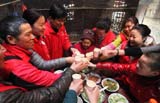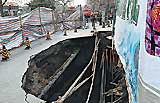Family doctors find acceptance hard to achieve
By Zhao Ruixue in Jinan and Shan Juan in Beijing (China Daily) Updated: 2012-05-19 07:47Health authorities have been working to introduce a family doctor model at the community level as part of China's healthcare reform, but the process hasn't gone smoothly in many areas.
A State Council plan has set a target, under the family doctor model, for 2020 of having two to three general practitioners at grassroots-level clinics to serve every 10,000 residents.
"By contracting with a family doctor for service, people can have more convenient and targeted medical care and ease strains on large hospitals.
"But it takes time and effort to make the public accept the new model," said Qin Huaijin, who leads the department of maternal and child health and community health under the Ministry of Health.
In Jinan, Shandong province, the new approach has not been well-received.
At Jinan's Tianqiao district, which has a population of 130,000, only 1,400 families signed contracts with general practitioners in the district's seven community healthcare centers.
Shandong launched the family doctor medical service last month, which mainly targets people above 65 years old, those with chronic diseases, pregnant women, people suffering from mental disorders and children younger than 6 years old.
Zhang Yujie, who worked as a chief doctor of traditional Chinese medicine at the Fourth People's Hospital in Jinan before shifting to the Banqiao Community Healthcare Center, was upset when attempting to make home visits.
"They think I am a swindler. They even don't give me a chance to explain to them," Zhang said.
Zheng Yang, Zhang's colleague, nearly cried recalling her experience visiting residents.
"How come they treated us so bad?" said Zheng, who trained for three years as a general practitioner at Jinan's Fourth People's Hospital.
"We are indeed qualified for treating some illnesses, and we can teach them how to take care of themselves to avoid getting serious diseases," Zhang said.
Still, Zhang believes residents will finally accept the family doctor service.
"The family doctor service is a new thing. It takes time to be accepted," Zhang said.
Also, the model was well-received among families that had actually tried it, citing efficiency and convenience.
After heart surgery, Tang Yufang had to take pills regularly. That meant many long waits at the hospital to get her pills. Now, she can just wait at home for the medicine to be sent by her family doctor.
"When I felt uncomfortable, I called Han Tao (Tang's family doctor) and he would come to my home and test me," Tang said. "It is very convenient."
In Beijing, health authorities plan to cover 70 percent of residents with chronic diseases or older than the age of 65 under the family doctor model.
"That, however, is no easy target," said Mao Yu, deputy director of the Beijing health bureau.
By last year, about 500,000 Beijing residents had contracted a family doctor for services like medical examinations, chronic disease management and health education.
In Shanghai, the model introduced last year at selected districts was welcomed by locals.
Zhao Xiaoge, deputy director of the community healthcare center of Changning district, said due to a doctor shortage, family doctors could only serve targeted groups like the old, babies and pregnant women.
Yang Hua, deputy director of the community department at the Fourth People's Hospital in Jinan, expressed concern over the family doctor model.
"To make the family doctor service go smoothly, authorities should also make sure to train enough general practitioners and give them policy preferences," Yang said. "We don't have enough general practitioners.
"We have about 100 general practitioners and nurses working at community healthcare centers. They are expected to cover a population of 130,000 in the district. You can imagine how hard the work is for them."
Contact the writers at zhaoruixue@chinadaily.com.cn and shanjuan@chinadaily.com.cn
- Xi stresses poverty relief for old revolutionary base areas
- Fireworks on windless holiday will mean drastic PM2.5 spike
- Policies designed to halt hidden bribes
- Spring festival gala ready for global show
- Chinese leaders extend festival wishes to predecessors
- Key pollutants to drop in 5 to 10 yrs
- Environmental concerns dampen firecracker sales
- Poor facilities pulling the plug on electric cars
- Party officials held accountable for work style violations
- Li gives residents keys to 'new life'







